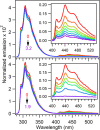Photoinduced Electron Transfer from the Tryptophan Triplet State in Zn-Azurin
- PMID: 36718260
- PMCID: PMC9881450
- DOI: 10.1021/acsphyschemau.2c00042
Photoinduced Electron Transfer from the Tryptophan Triplet State in Zn-Azurin
Abstract
Tryptophan is one of few residues that participates in biological electron transfer reactions. Upon substitution of the native Cu2+ center with Zn2+ in the blue-copper protein azurin, a long-lived tryptophan neutral radical can be photogenerated. We report the following quantum yield values for Zn-substituted azurin in the presence of the electron acceptor Cu(II)-azurin: formation of the tryptophan neutral radical (Φrad), electron transfer (ΦET), fluorescence (Φfluo), and phosphorescence (Φphos), as well as the efficiency of proton transfer of the cation radical (ΦPT). Increasing the concentration of the electron acceptor increased Φrad and ΦET values and decreased Φphos without affecting Φfluo. At all concentrations of the acceptor, the value of ΦPT was nearly unity. These observations indicate that the phosphorescent triplet state is the parent state of electron transfer and that nearly all electron transfer events lead to proton loss. Similar results regarding the parent state were obtained with a different electron acceptor, [Co(NH3)5Cl]2+; however, Stern-Volmer graphs revealed that [Co(NH3)5Cl]2+ was a more effective phosphorescence quencher (K SV = 230 000 M-1) compared to Cu(II)-azurin (K SV = 88 000 M-1). Competition experiments in the presence of both [Co(NH3)5Cl]2+ and Cu(II)-azurin suggested that [Co(NH3)5Cl]2+ is the preferred electron acceptor. Implications of these results in terms of quenching mechanisms are discussed.
© 2022 The Authors. Published by American Chemical Society.
Conflict of interest statement
The authors declare no competing financial interest.
Figures








Similar articles
-
Photogeneration and Quenching of Tryptophan Radical in Azurin.J Phys Chem B. 2015 Jul 23;119(29):9438-49. doi: 10.1021/jp511523z. Epub 2015 Feb 17. J Phys Chem B. 2015. PMID: 25625660 Free PMC article.
-
Role of the Triplet State and Protein Dynamics in the Formation and Stability of the Tryptophan Radical in an Apoazurin Mutant.J Phys Chem B. 2022 Sep 15;126(36):6751-6761. doi: 10.1021/acs.jpcb.2c02441. Epub 2022 Aug 17. J Phys Chem B. 2022. PMID: 35977067 Free PMC article.
-
Room-temperature phosphorescence from azurin derivatives. Phosphorescence quenching in oxidized native azurin.Photochem Photobiol. 1992 May;55(5):671-6. doi: 10.1111/j.1751-1097.1992.tb08509.x. Photochem Photobiol. 1992. PMID: 1528979
-
Electron tunneling in rhenium-modified Pseudomonas aeruginosa azurins.Biochim Biophys Acta. 2004 Apr 12;1655(1-3):59-63. doi: 10.1016/j.bbabio.2003.06.010. Biochim Biophys Acta. 2004. PMID: 15100017 Review.
-
Cu(A) centers and their biosynthetic models in azurin.J Biol Inorg Chem. 2010 May;15(4):461-83. doi: 10.1007/s00775-010-0625-2. Epub 2010 Feb 19. J Biol Inorg Chem. 2010. PMID: 20169379 Review.
Cited by
-
Modeling the Weak pH Dependence of Proton-Coupled Electron Transfer for Tryptophan Derivatives.J Phys Chem Lett. 2023 Dec 14;14(49):10980-10987. doi: 10.1021/acs.jpclett.3c02282. Epub 2023 Dec 1. J Phys Chem Lett. 2023. PMID: 38039095 Free PMC article.
References
LinkOut - more resources
Full Text Sources
